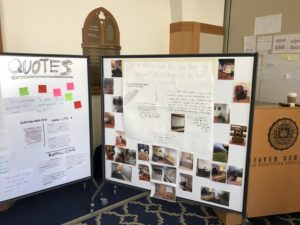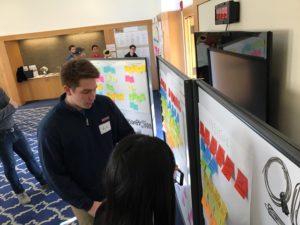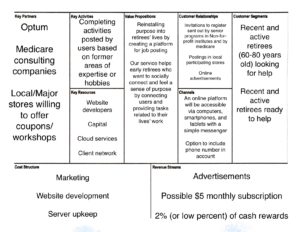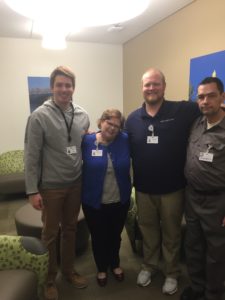Author: Nicholas
Prototype Feedback
In the prototyping stages, we waited for Pat’s input on our ideation summary to begin testing. Since Pat basically eliminated two of our ideas from possibility, we were able to focus our testing on the job board website. The group created some iPhone screen mock-ups for users to examine. Even though the main channel will be a typical computer with internet access, the iPhone screens gave us the opportunity to accentuate the main ideas of the job board. After visiting the Saint Joseph PACE Center and speaking with team family members, the group acquired some valuable feedback. Retiree Gayle Books, a former KFC employee and PACE participant, stated “I need a buddy like you there” while I was explaining who the users would meet up with to complete tasks. This pointed to a major oversight in the prototype: we had only allowed one user to help another single user. Adding options to combine the expertise of multiple users to tackle problems made sense in that complicated jobs could now be easier to complete and teamwork would lead to more social connectivity amongst users. One of the main things Professor Angst stressed is the E for Enticing, so the group tested which incentives were most coveted. Desired rewards seemed to fluctuate randomly. Cash rewards reigned supreme in the end, especially according to individuals with lower retirement savings. Thus, the job board should have an option for a cash reward on each posting. Lastly, ideally local stores and companies would be involved by offering discounts to products/services related to areas of expertise. PACE Activity Director Joe Collins pointed out the missed opportunities from these local stores possibly posting simple jobs, or even workshops, onto the job board. This would allow stores to get cheap, or even volunteer, labor while also increasing a sense of community for the users. Also, beginner style workshops could excite the users to develop skills in the hobbies they want to pursue.
Key Takeaways:
- To fix users’ weariness about meeting up with strangers looking for jobs, the website should offer a “buddy” system that allows friends to team up on tasks and split the rewards.
- Participating local stores should also be able to post smaller jobs and even workshops that inhibit connections between users in certain areas of expertise.
- Users, especially ones with lower retirement savings, prefer cash as an incentive to complete tasks.
iPhone Mock-up Pictures:
Second Call with Pat
In the second call with our client Pat Karen on Tuesday, April 25, we proposed our three product ideas in the form of our ideation summary. We went into the call believing our smartwatch was the best idea and an idea that could incorporate the other applications into it, but Pat almost immediately shot it down due to the intense popularity and established competitors in the market (Apple Watch, Fitbit). He did admire the need for the physician to prescribe the watch since the older population is resistant to commands. Our second idea, the schedule, was too close to a service like Google calendars, and Pat believed that it would not meet the needs of our target user. He had little more to say about the schedule, so we all though the phone call was a train-wreck. Fortunately, the online job board/job sharing service intrigued Pat the most. This surprised the group initially, but after talking it over it made sense to pivot away from the watch. He agreed with us that the product could fulfill the social needs of the user while also providing constant engagement, both physical and mental. Our initial worry was that the job board would only be accessible through internet friendly devices such as tablets and laptops that may not be easy to get a hold of, but Pat insisted that the job board should be available through all internet platforms. This phone call gave us a clear product choice from the client’s perspective to focus on.
Key Takeways:
- The smartwatch market is cluttered with products in development and huge competitors like the Apple Watch. Even though the wearable was initially our most promising idea, we have to pivot away from it.
- The job sharing service could actually succeed as a solution to some of the needs of our user, specifically social interaction and constant engagement with activities familiar to the user.
- The main thing to focus on in the prototyping stage is the incentives. While we have an idea for a rewards system, it is key to flesh out which ones users actually prefer.
Interactive Ethnography: Graffiti Wall
Before immersing ourselves in Wood Ridge Assisted Living, I contacted Angela in order to setup a graffiti wall a week in advance. She suggested that we place the graffiti wall in the employee break room. Our question, aimed towards the caregivers, was, “What advice would you give your younger self to prepare for becoming a caregiver?” After a week, 7 people responded to the question. While this was not the turnout we were looking for, Connor and I gathered some details about caregivers, one of the pivotal stakeholders of our project.
Key Takeways:
- Caregivers do not do the job for money, as they often make low wages.
- Becoming a caregiver takes a lot of hard work, training, and studying. It is not a job simply for kind-hearted individuals.
- Making retirees days gives caregivers immense joy. Fortunately, it is often not tough to make the elderly happy, as they often just need a good listener and company.

Gallery Day Reflection
Getting to discuss the ethnographic research with our client, Pat Karen, helped clear several things up looking forward. First, he highlighted that we did not have a diverse enough population of interviewees. Our group did not include research on several races or socioeconomic statuses, which is a problem going forward. Our product may have to be tailored to the wealthier user, since most of our data is on upper class white men. Second, we need to find a way to incorporate the internet of things into the product. The product will be technologically advanced, and there are two categories we need to pick between: preventative and surveillance. That is, the technology should be used either to prevent the user from leaving their home or to survey or watch the user and help them in that manner. Last, the product needs to be simple, personalized, and engaging. Our research showed that retirees are resistant to technology and commands from younger people. By making the product personalized and simple, retirees should be able to engage with and enjoy the product. We also spoke briefly with the former Stanford design graduate. He provided some helpful tips on future ethnographic research, such as focusing questions around extremes. He also pointed out that observations of needs should be phrased in terms of verbs, while the solution should show up as a noun.
Key Takeaways:
- The research we gathered was helpful and a great starting point, but we need to use more diverse populations and ask questions using extremes.
- The product must center around the internet of things. Since our research shows that older retirees are more resistant to technology, our user should be new retirees (around 65 years old).
- The product must be simple, personalized, and engaging. Users want to do retirement their way, so the product should be simple enough to customize, use, and engage with.

Prototype Plan
Product 1: Smartwatch
Consider the Setting:
For our smartwatch prototype, our best approach to receiving valuable feedback would be to test the product in the context where it will ultimately be used. Ideally, this product would be tested in the setting of a doctor’s office, where a doctor would discuss the idea of this new product with the patient. If by this point the prototype is fully functional, the user would get to take it home with them and use it for about a week in conjunction with their doctor. At the end of the week, representatives from our group would perform certain activities with both the doctor and the patient to better understand how the product was received.
Define what to test:
We need to see why our watch would stand out against the surplus of wearables in the market. With established wearables such as the Apple Watch and Fitbit, it is a tough market to penetrate. Our product looks to combine the positive aspects of both wearables, but will this be an incentive to use it or will it be too tech-savvy to use? Testing how interactive the technology needs to be and how much work is required by the user is ideal. A health based wearable is not the most sexy idea, so what features should be added that will incentivize the user to use it.
We would also get feedback from doctors in order to understand how well the device works for them to monitor and communicate with their patients. Would the information from the watch be useful for the doctors to assess health? Also, do physicians even need constant data for anything other than emergency situations? Lastly, we need to test how many patients the doctor will be comfortable with having and if constant checkups with the users would be a better substitute.
Define feedback activities:
Interviews and surveys would provide the best and most detailed feedback from users. We would aim to record reactions and opinions about the product at the initial time of receiving the product as well as after some decided adjustment period.
Product 2: Cellular Application
Consider the Setting:
Scheduling will take place within the app, on a device owned by the retiree. The application can be used on the go. Scheduled events can take place anywhere, but recommended events will be drawn primarily from the local community to minimize the amount of travel required.
Define what to test:
The schedule will need to provide enough value for the user to use. We will test the importance of items that aren’t activities, such as simple games or inspirational quotes. Since the calendar is focused on forcing constant activity, we need to observe if the organized schedule will actually improve engagement. That is, if the user likes the schedule but does not actually partake in the activities, the product will be considered a failure. What level of “hand holding” or recommended/pre prepared scheduling do retirees want? One of our key insights is that the users do not like being forced into doing anything, so we need to test how forceful a prepared schedule would appear. While the schedule would ideally organize several activities each day, there should be a limit to how many activities users are comfortable with having. Do retirees want/need a schedule? We also need to see if newly retirees even need a scheduling service. Perhaps retirees will want to have no organization and live life on a whim.
Define feedback activities:
Interviews, surveys, use of google calendar as a direct comparison
Product 3: Retiree Job Board
Consider the Setting:
Product will be used in the retiree’s home. Work on job postings will take place primarily over the internet and over the phone. Certain jobs must be completed at a physical location that will be set by the users.
Define what to test:
The key thing we need to test is what rewards incentivize use of the product the most. Although the key component of the idea is to fulfill a sense of purpose in the user, doing labor for free is not always ideal. Rewards range from small cash prizes to coupons from local stores related to the area of expertise. The product is also aimed to provide a social aspect for the users by connecting them with people in similar areas of expertise. Since mostly anybody can post a job on the website, we need to figure out if users are okay with working with strangers and what the best method of communication is. Also, the product is aimed for constant engagement, so it is important to test how challenging the jobs can be and how often people will want to use the service.
Define feedback activities:
Mock job postings, user feedback on UI and site layout, interviews
Ethnographic Summary- Immersion
Nicholas Homolka immersed in an assisted living care facility in order to observe the pros and cons of living outside of the home.
Date: 3/4/17
Type: Immersion
Location: Wood Ridge Assisted Living
Team Participants: Connor De Mill, Nicholas Homolka
User Characteristics: “Residents of Assisted Living Care”
- Average Age of Residents: around 77 years (60-94)
- Cheaper living option with 24/7 care and surveillance from nurses
- “Not just here, but every place I’ve worked the residents have had issues with the way things were managed. Administrative issues. They want to see stuff changed and who is in authority.”
- “The administrator here is pretty cool about issues. She literally has an open-door policy where residents are encouraged to come in and share their issues. She will get on it then.”
Assisted Living Duration: Varies largely for Residents
Arrival: Referred by another facility, doctor, or family home (Where primary caregivers have been family)
Memorable Quotes from Interview: “Actually not trying to be funny but they complain about everything.”
Daily Routine
- Day starts at 8
- Daily Activities
- Breakfast: 8 am
- Lunch: 12:30 pm
- Dinner: 5:30 pm
- Meals are on a certain schedule so there is a good sense of variety
- Open to use the facility in whatever way they desire
- Certain group activities are offered
*Day is personal for each resident (do not have to participate)
Top 3 Learnings:
- Assisted Living homes are somewhat like apartment complexes, they just have the added benefit of nurse care and surveillance
- The residents all have different situations, and one resident could be very active (like using an Amazon Echo and playing Candy Crush) or very inactive (sitting on the living room couch all day)
- Family members do not visit as often since the residents are more independent. Thus, the residents must get to know each other or live in solitude.
Key Insights – (1) Doing anything besides sitting on the couch all day is helpful. Simple tasks such as doing one’s own laundry keeps the mind working for a longer time (2) Being alone is extremely deteriorating to one’s health. Retirees enjoy discussions about anything, so it is important to visit loved ones and spend some time with retirees (3) Retirees do not enjoy the care they receive, and would much rather be in their homes and not bossed around.
Activities:
- Examples offered in Nursing Home
- Gardening
- Family Visits & Children
- Television
- Music
Environment
- Wood Ridge Assisted Living
- 67 residents
- Toured facility
- Bedrooms- singles and doubles
- Administration Office
- Front Desk
- Welcome Area
- Living rooms
- Laundry rooms
- Early-Afternoon: 12-3 pm
- Other assisted living homes nearby
Interactions:
- Our Activities
- Parked in Parking Lot
- Entered through two sets of doors
- Sat in Welcome Area
- Met with Angela to set things up as well as take the tour
- Placed graffiti wall in employee rest area
- Observed lunch time in the cafeteria, the busiest time of the day
- Interviewed Matthew and Annie
- Left Facility
Objects:
- Board Games
- Television Sets
- Tables, Chairs, & Couches
- Water coolers
- Garden
- Laundry machines
Users:
- Residents
- Nursing Staff
- Administrators
- Loved Ones
- Guest Visitors
Workarounds
Las Vegas is not the most picture friendly place, so I took some pictures off the internet to show some workarounds I noticed.
Each table uses chips instead of money, which allows the dealers to store and distribute the money in an easier way. Also, the chip design separates the user from the real value it represents.

Convenient signs outside of the hotel guide the uber drivers and users away from the crowded front entrances of the resorts. The rise in popularity of uber and lyft made this a necessary workaround.

Lastly, people in the sports book room would use any item, such as Sbarro’s pizza boxes or a hat, to indicate that they were still using a specific seat. This workaround came about since there was high demand for seating in the room due to March Madness.

Ethnographic Research- Expert Interview with a CNA
Date: March 4, 2017
Type: In person expert interview
Location: Wood Ridge Assisted Living
Team Participant: Nicholas and Connor
Interview Audio File: https://drive.google.com/open?id=0B5skxyf9hGZBVEVRRU94WDF4UUk
Interview Transcript: https://drive.google.com/open?id=0B-SBU6BZXoGmc1BnVGUzV1ZyMU0
Nicholas and Connor interviewed Matthew, one of Wood Ridge Assisted Living’s Certified Nursing Assistants (CNA). The marketing director handpicked this employee who works only on Mondays and Wednesdays. He has been in the caregiving business for over 20 years, pointing to his expertise.
Characteristics:
- Age: 46
- Gender: Male
- Marital Status: Unknown
- Occupation: Certified Nursing Assistant
- Lived in Chicago, IL
- Has been a CNA for over 20 years
Memorable Quotes:
“Making somebody’s day believe it or not. Sitting down with the resident and letting them share a story, make their bed, little simple stuff. Makes me happy when they say they really appreciate it.”
“Not just here, but every place I’ve worked the residents have had issues with the way things were managed. Administrative issues. They want to see stuff changed and who is in authority.”
“Stay active. That’s the number one. My mother just turned 84 and she is still a full time employee. What happens when you retire you are just sitting around the house not using your mind a lot and eating without proper exercise. Whatever condition you have does not get better with just sitting around. Even if you retire you should volunteer and do activities.”
Key Insights:
- Individuals want to stay in the home as long as possible
- Knowing the individual well is paramount
- Staying active, including the little things in life, will extend the length of time in your home
- Older people do not want to be told to do things, even if it is for their health’s sake.
- Retirees need to keep being social in order to not feel lonely, which contributes to mental health disorders and the deterioration of health.
Emerging Patterns:
Retirees need to stay active both mentally and physically in order to maintain their overall wellbeing. Seniors do not want to be told what to do and would rather live in their homes for as long as possible. Critical events such as diagnoses of serious mental health issues usually force people out of their homes. However, the caregivers seemed to want to continue working even after typical retirement ages in order to keep themselves sharp.
Analogous Immersion- Freshman Year of College
Freshman year of college is analogous to retirement since it is a transitional stage of life. Although freshman year of college adds more stress and work to your life, people also gain a sense of freedom compared to living with their parents beforehand. One will learn several new things about themself in college, and new retirees will get to do what they want given the resources, which emphasizes their true passions and goals. People can also choose what communities to be in and begin new hobbies and interests. Students also find friends that stay in their lives even through retirement. These are stages in life that people cannot avoid, so they prepare in several different ways to make the stages better.
Notre Dame Freshman Class of 2014:
- 2,010 students
- 110 international students, and is one of the most diverse classes in the history of ND
- Average student must travel 900 miles to campus
- Top 15 university
- Jobs include: professors, administration, the President of the University, various hall staff positions, St. Liam’s employees
Key Takeaways:
- A new sense of freedom can result in positives and negatives. While freedom allows people to pursue their goals and favorite hobbies, it can also lead to unhealthy habits and a sense of loneliness.
- Entering a new stage of life brings new relationships with a diverse set of people. Getting outside of your comfort zone may be challenging at first, but noticing that change can be a good thing early on makes the experience more pleasant.
- Joining specific communities can bring a purpose to your life and new people that you share interests with.
- Training your mental and physical health will improve your life in the short term and long term, and at the end of the day it is the student’s or new retiree’s responsibility to maintain their health and stay informed about it.
- Utilizing the resources around you, such as professors, career advisors, or various doctors, will help you stay informed on how to live a good life. Transitional stages of life almost always require help from others, and it is important to accept that you should not be alone through them. This holds true even if what the resources are saying something other than what you want to hear.

